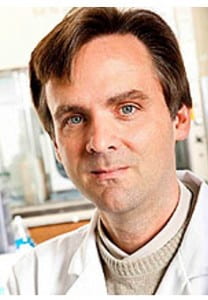My lab studies the enzymes viruses use to multiply in human  cells in order to develop better antiviral drugs. We are mainly interested finding better treatments for the hepatitis C virus (HCV) and related viruses.
cells in order to develop better antiviral drugs. We are mainly interested finding better treatments for the hepatitis C virus (HCV) and related viruses.
DNA replication fidelity & the discovery of the NUDIX house-cleaning protein family. My PhD thesis work was focused on understanding how cells replicate their genomes with extraordinarily high fidelity. I approached this problem by studying “mutator” genes, which typically encode proteins that proofread or repair DNA. The gene I worked with is called mutT, and it was known at the time to encode a protein that hydrolyzes dGTP to prevent transversion mutations. We studied the MutT protein active site to understand how the protein preferentially hydrolyzes damaged dGTP that might mispair with template adenosines (Frick et al., 1995b). We noted that the MutT active site contains a conserved motif, and by purifying and characterizing homologous proteins, we discovered that proteins that share this motif all hydrolyze nucleoside diphosphates linked to some other compound “x” (Frick and Bessman, 1995; Frick et al., 1995a). Further research on such “NUDIX” proteins ultimately led to the discovery of dozens of new enzymes that cleanse cells of damage nucleotides, unneeded second messengers, and that remove 7-methylguanylate 5’-caps from mRNAs that are no longer needed for gene expression (Bessman et al., 1996).
DNA Replisome. As a postdoctoral fellow, I joined a team of investigators who were working to reconstitute a functional DNA replication complex (replisome) from recombinant purified proteins. We studied the phage T7 DNA polymerase, its processivity factor, the T7 helicase/primase and single stranded binding proteins. Together these proteins were the first to be used to study coordinated leading and lagging strand replication and verify the “trombone model’ of DNA replication in vitro. Though cut short for medical reasons, my work at Harvard Medical School helped show how DNA primase and helicase coordinate Okazaki fragment synthesis in DNA replication at specific template recognition sequences (Frick and Richardson, 1999), and I helped obtain some of the first primase and helicase crystal structures (Kato et al., 2001). I’ve also written extensively on DNA primases (Frick and Richardson, 2001). With colleagues at New York Medical College, I continued to apply what we learned with the phage enzymes to help identify new components of the human DNA replisome (Meng et al., 2010).
HCV Polymerase characterization & antivirals targeting NS5B. The first HCV enzyme I studied as a principal investigator was the viral RNA-dependent RNA polymerase called NS5B. We were the first lab to purify NS5B from several of the most common HCV genotypes, and we used them to test the hypothesis that ribavirin exerts its HCV antiviral effect because a NS5B inserts ribavirin into RNA where it acts as a lethal mutagen. Our data did not support the idea that ribavirin acts as a lethal mutagen (Heck et al., 2008). However, we instead clearly showed that chain-terminating nucleosides, unlike non-nucleoside NS5B inhibitors, are effective against all HCV genotypes (Heck et al., 2008). We later showed similar pan-genotypic activity for the drug that was to eventually become sofosbuvir (Lam et al., 2010). My lab also showed how purified cyclophilin B activates the ability of NS5B to synthesize RNA in vitro, a discovery that might explain the antiviral effect of the immunosuppressant cyclosporine, which has been observed in the clinic (Heck et al., 2009).
NS3 helicase enzyme characterization. Our interest in studying the HCV helicase as a drug target began about fifteen years ago, and we have published more than 25 papers on the subject. We extensively characterized the HCV helicase, identified key new motifs, like a beta-loop used in similar proteins to separate nucleic acid duplexes (Lam et al., 2003) and that the protease domain helps assist the helicase (Frick et al., 2004). We also extensively characterized the helicase substrate specificity (Belon and Frick, 2009) and showed that the helicase is needed in the cell for virus replication (Lam and Frick, 2006).
 Helicase inhibitors as novel antivirals. In recent years, my lab developed numerous new high-throughput screening assays to discover helicase inhibitors (Hanson et al., 2012). We used one of these molecular-beacon based assays to screen about 300,000 compounds in the NIH library for HCV helicase inhibitors. We developed one of the few hits into a series of probes (Li et al., 2012), some of which are also potent inhibitors of NS3 from dengue virus and West Nile virus (Sweeney et al., 2015). One of these compounds can also be used to enhance the efficacy of protease inhibitors being tested as new HCV drugs in the clinic (Ndjomou et al., 2015).
Helicase inhibitors as novel antivirals. In recent years, my lab developed numerous new high-throughput screening assays to discover helicase inhibitors (Hanson et al., 2012). We used one of these molecular-beacon based assays to screen about 300,000 compounds in the NIH library for HCV helicase inhibitors. We developed one of the few hits into a series of probes (Li et al., 2012), some of which are also potent inhibitors of NS3 from dengue virus and West Nile virus (Sweeney et al., 2015). One of these compounds can also be used to enhance the efficacy of protease inhibitors being tested as new HCV drugs in the clinic (Ndjomou et al., 2015).